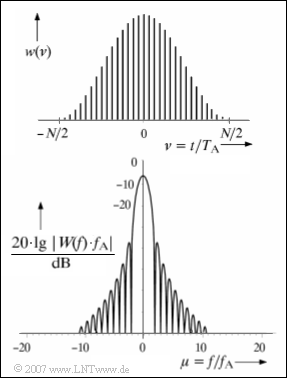Difference between revisions of "Aufgaben:Exercise 5.4Z: On the Hanning Window"
m (Text replacement - "Category:Exercises for Signal Representation" to "Category:Signal Representation: Exercises") |
m (Guenter moved page Exercise 5.4Z: On The Hanning Window to Exercise 5.4Z: On the Hanning window) |
(No difference)
| |
Revision as of 13:36, 19 May 2021
In this task, important properties of the frequently used Hanning window are to be derived. The continuous-time representation in the interval from $-T_{\rm P}/2$ to $+T_{\rm P}/2$ is here as follows:
- $$w(t)= {\rm cos}^2(\pi \cdot {t}/{T_{\rm P}})= 0.5\cdot \big(1 + {\rm cos}(2\pi \cdot {t}/{T_{\rm P}}) \big ) \hspace{0.05cm}.$$
Outside the symmetric time domain of duration $T_{\rm P}$ ist $w (t) \equiv 0$.
The upper graph shows the discrete-time representation $w(\nu) = w({\nu} \cdot T_{\rm A})$, where $T_{\rm A}$ is smaller than $T_{\rm P}$ by a factor $N = 32$ . The definition range of the discrete time variable $ν$ extends from $-16$ to $+15$.
In the lower graph, the Fourier transform $W(f)$ of the continuous-time window function $w(t)$ is shown logarithmically. The abscissa is normalised to $f_{\rm A} = 1/T_{\rm P}$ . One can see:
- The equidistant values $W({\mu} \cdot f_{\rm A})$ are zero except for $μ = 0$ and $μ = ±1$.
- The main lobe thus extends to the frequency range $|f| ≤ 2 · f_{\rm A}$.
- $W(f)$ is largest in magnitude outside the main lobe for $f = ±2.5 · f_{\rm A}$ ..
- Thus, the minimum distance between the main and side lobes applies here:
- $$A_{\rm H/S} = 20 \cdot {\rm lg}\hspace{0.15cm} \frac{|W(0)|}{|W(2.5 \cdot f_{\rm A})|} \hspace{0.15cm}{\rm (in}\hspace{0.1cm}{\rm dB)}\hspace{0.05cm}.$$
Hints:
- This task belongs to the chapter Spectral Analysis.
- Note that the frequency resolution $f_{\rm A}$ is equal to the reciprocal of the adjustable parameter $T_{\rm P}$ .
Questions
Solution
- $$w(t) = {\rm cos}^2(\pi \cdot {t}/{T_{\rm P}}) = 0.5+ 0.5\cdot {\rm cos}(2\pi \cdot {t}/{T_{\rm P}})\hspace{0.05cm}.$$
- After time discretisation with $ν = t/T_{\rm A}$ and $T_{\rm P}/T_{\rm A} = N = 32$ , one obtains for the discrete-time window:
- $$w(\nu) = w(\nu \cdot T_{\rm A}) = 0.5+ 0.5\cdot {\rm cos}(2\pi \cdot {\nu}/{N})\hspace{0.8cm} \Rightarrow \hspace{0.3cm}w(\nu = 0) \hspace{0.15 cm}\underline{= 1},$$
- $$w(\nu = 1) = 0.5+ 0.5\cdot {\rm cos}( \frac{\pi}{16})\hspace{0.15 cm}\underline{ = 0.99}, $$
- $$w(\nu = -8)=0.5+ 0.5\cdot {\rm cos}( \frac{-\pi}{2}) \hspace{0.15 cm}\underline{= 0.5}\hspace{0.05cm}.$$
(2) The correct solutions are 2 and 3::
- The periodic continuation of $w(t)$ corresponding to the period $T_{\rm P}$ yields a (periodic) signal with a DC and a cosine component.
- From this follows with $f_{\rm A} = 1/T_{\rm P}$:
- $${\rm P}\{w(t)\} = 0.5+0.5\cdot {\rm cos}(2\pi \cdot f_{\rm A} \cdot t) \hspace{0.2cm}\circ\!\!-\!\!\!-\!\!\!-\!\!\bullet\, \hspace{0.2cm}0.5\cdot {\rm \delta}(f) + 0.25\cdot {\rm \delta}(f \pm f_{\rm A}))\hspace{0.05cm}.$$
- The time-limited signal $w(t)$ is obtained from ${\rm P}\{w(t)\}$ by multiplication with a rectangle of amplitude $1$ and duration $T_{\rm P}$.
- Its spectrum $W(f)$ is thus obtained from the convolution of the above spectral function with the function $T_{\rm P} · {\rm si}(π \cdot f \cdot T_{\rm P}) = 1/f_{\rm A} · {\rm si}(π \cdot f/f_{\rm A})$:
- $$w(t) \circ\!\!-\!\!\!-\!\!\!-\!\!\bullet\, W(f) = \frac{0.5}{f_{\rm A}}\cdot {\rm si}( \frac{\pi f}{f_{\rm A}})+ \frac{0.25}{f_{\rm A}}\cdot {\rm si}(\pi \cdot \frac{f-f_{\rm A}}{f_{\rm A}})+ \frac{0.25}{f_{\rm A}}\cdot {\rm si}(\pi \cdot \frac{f+f_{\rm A}}{f_{\rm A}})\hspace{0.05cm}.$$
- This spectral function is even and also real for all frequencies $f$ . The spectral value at frequency $f = 0$ gives the window area:
- $$W(f=0) = \frac{0.5}{f_{\rm A}}= \int_{-\infty}^{+\infty}w(t)\hspace{0.05cm}{\rm d}t\hspace{0.05cm}.$$
(3) From the result of sub-task (2) it also follows:
- $$W(f = ±f_{\rm A}) = W(0)/2\hspace{0.15cm}\underline{ = 0.25} \cdot 1/{f_{\rm A}}.$$
- Due to the monotonic course in the range $|f| < f_{\rm A}$ , the magnitude function $|W(f)|$ has dropped to half of the maximum for the first time exactly at $± f_{\rm A}$ .
- Thus, $B_{\rm 6\hspace{0.05cm}dB}\hspace{-0.05cm}/\hspace{-0.05cm}f_{\rm A} \;\underline{=2}$.
(4) The largest spectral amount outside the main lobe occurs at $f = ±2.5 f_{\rm A}$ . With the result of subtask (2) holds:
- $$W(f = 2.5 \cdot f_{\rm A}) = \frac{0.5}{f_{\rm A}}\cdot {\rm si}(2.5 \pi ) +\frac{0.25}{f_{\rm A}}\cdot {\rm si}(1.5 \pi )+\frac{0.25}{f_{\rm A}}\cdot {\rm si}(3.5 \pi )= \frac{0.25}{\pi \cdot f_{\rm A}}\left[ \frac{2}{2.5}-\frac{1}{1.5}-\frac{1}{3.5}\right] \approx -\frac{0.0121}{ f_{\rm A}}\hspace{0.05cm}.$$
- This gives the minimum distance between the main lobe and the side lobes:
- $$A_{\rm H/S} = 20 \cdot {\rm lg}\hspace{0.15cm} \frac{|W(0)|}{|W(2.5 \cdot f_{\rm A})|} = 20 \cdot {\rm lg}\hspace{0.15cm} \frac{0.5}{0.0121}\hspace{0.15 cm}\underline{\approx 32.3\,\,{\rm dB}}\hspace{0.05cm}.$$
